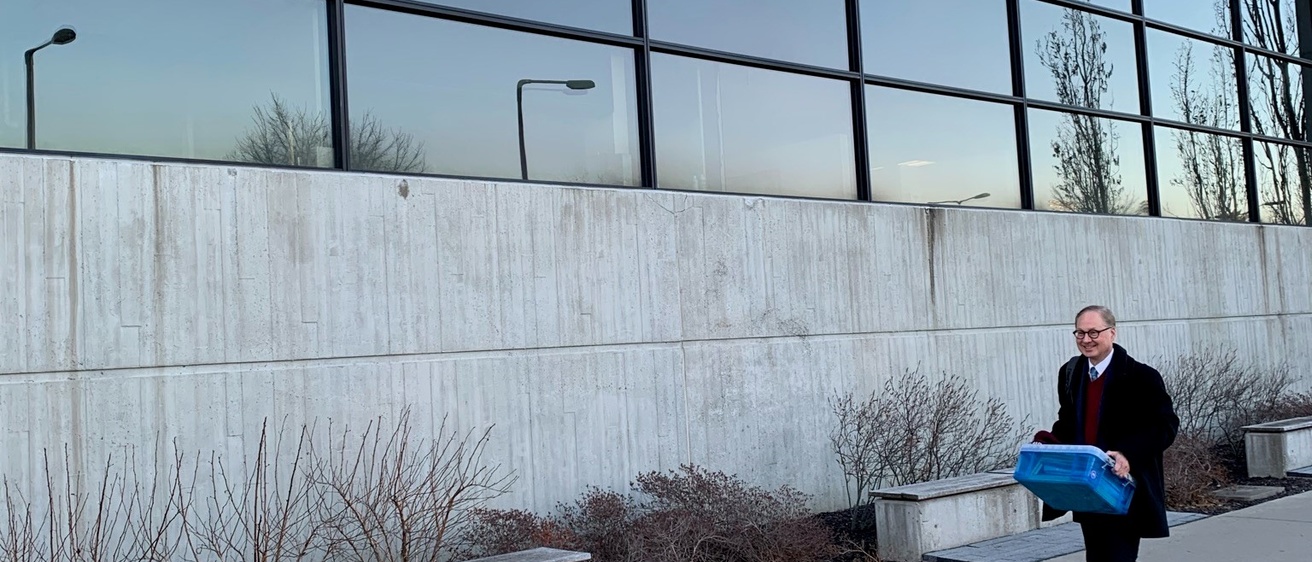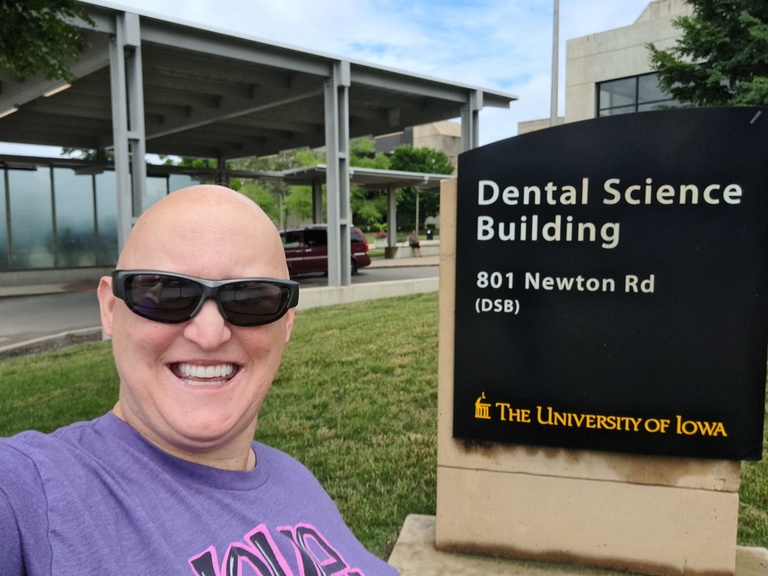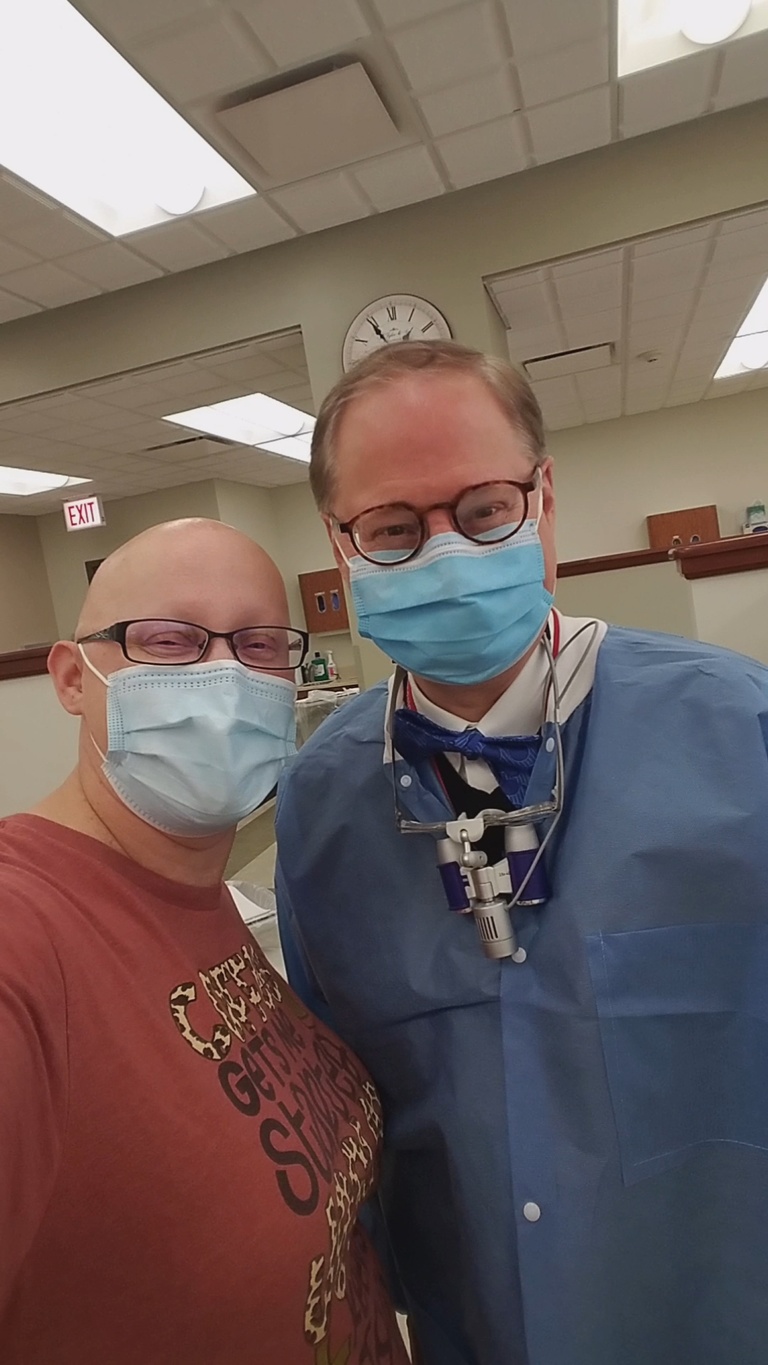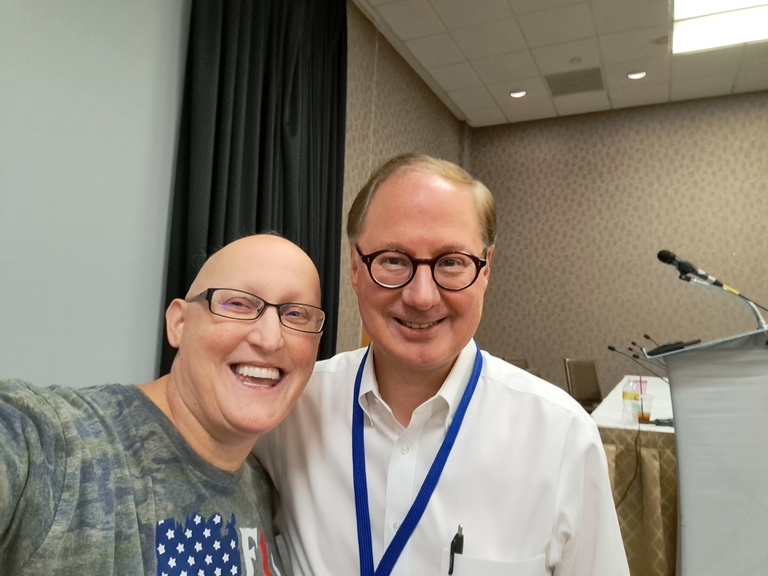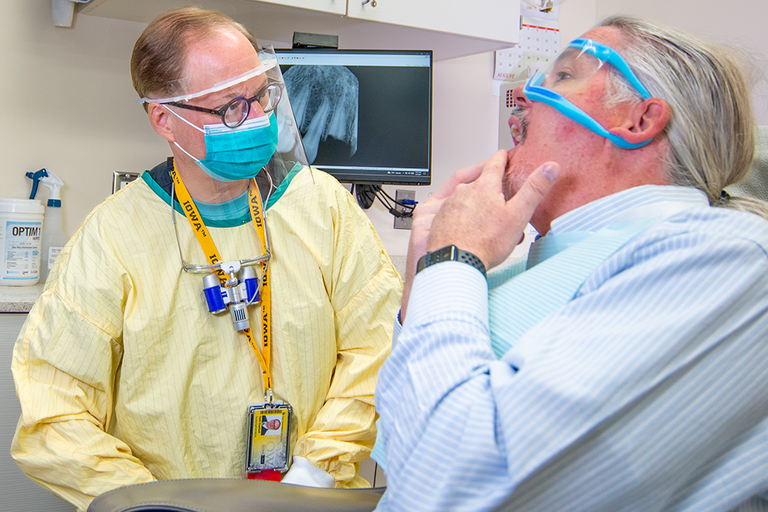by Michael Tilley
With a tote of office supplies in hand, Clark Stanford (’87 DDS, ’92 PROSS, ’92 PhD) returned to his alma mater to become the 14th dean of the University of Iowa College of Dentistry and Dental Clinics on April 1, 2022.
It was a homecoming for Stanford who earned his bachelor’s degree, DDS, PhD, and certificate in prosthodontics all from the University of Iowa where he rose through the ranks on faculty to become associate dean for research. Eight years earlier, Stanford left the University of Iowa to become dean of the University of Illinois-Chicago College of Dentistry (UIC).
But even during this time, Iowa was always his home. In fact, he didn’t even sell his house in Iowa City.
“The character of the college hasn’t changed,” Stanford said with a smile, “especially the warmness and the close ties among the faculty, staff, residents, and students.”
Other things haven’t changed either. He still loves to visit local coffee shops on the Ped Mall, walk in the woods by his house, and spend time with his cat, Zoey.
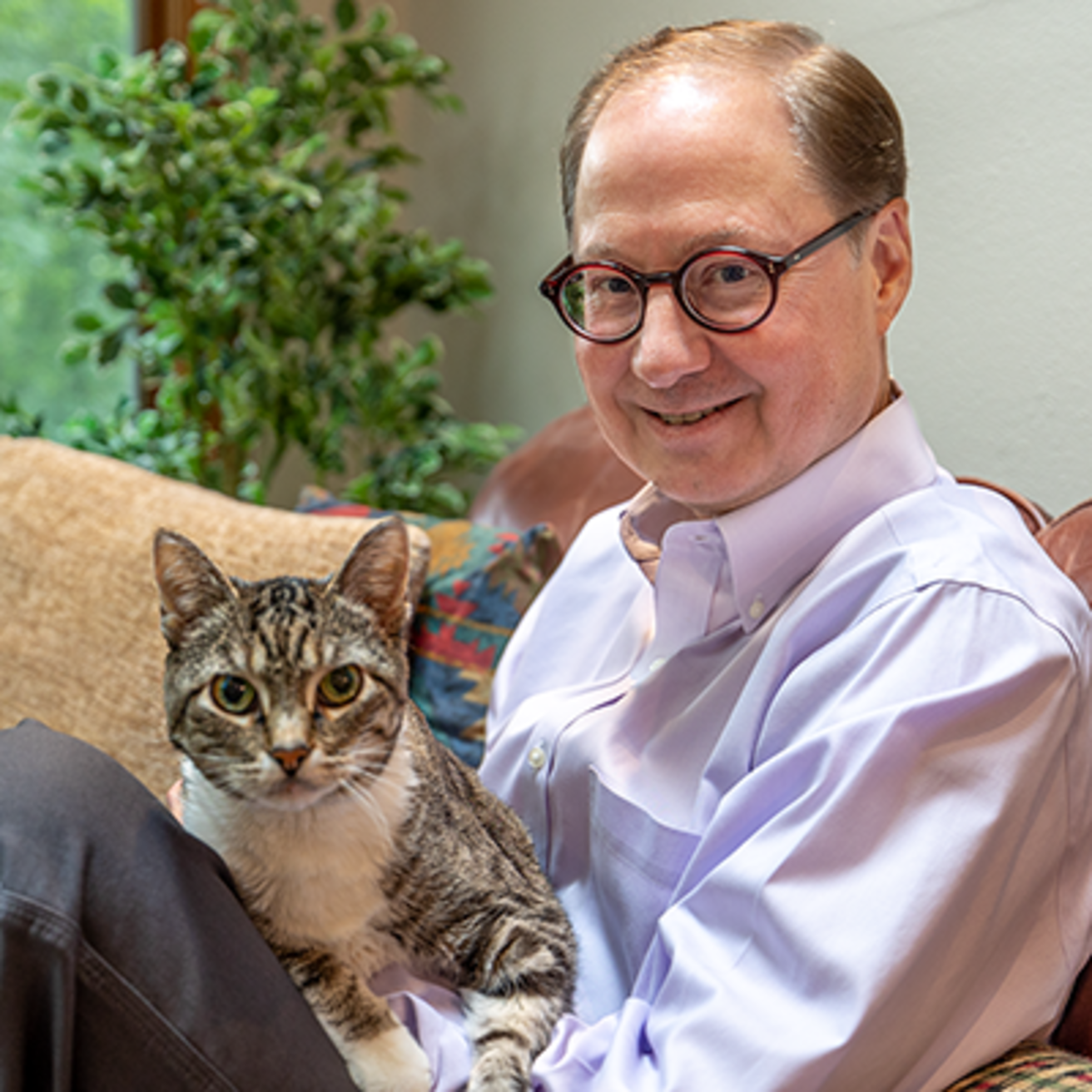
Doing the Impossible for Patients
There are seven words you’ll never hear out of Stanford’s mouth when talking to patients: “This is the best we can do.” He is driven to find new treatment options, solve tricky clinical problems and, sometimes along the way, do the impossible.
Shortly after arriving back at Iowa, Stanford resumed his clinical practice.
“Seeing patients is central to who we are as a college, and I wanted to ensure that I always have that close connection to the impact that our policies have on our clinical care providers and our patients,” Stanford said.
It’s also clear that he finds great joy meeting the needs of his patients. Particularly those who have a rare genetic disorder—ectodermal dysplasia—that can result in missing teeth or bone among other possible conditions.
Many children with the disorder may only have one or two teeth, and they will often experience excessive amounts of bullying directed at their physical appearance.
“He really makes it his goal to care well for his ectodermal dysplasia patients, and you can tell that he is moved with compassion by their oral health needs,” explained one colleague.
For one family who drove from out of state to see Stanford, their son had a severe case of ectodermal dysplasia and needed his service dog to relax and feel comfortable. For all patients, the college will accommodate service animals as much as it can legally, but Stanford knew
more was needed in this case.
He knew how important the dog was to his young patient and had them both come back together for treatment. At one point, the dog put his head on Stanford’s leg to keep a closer eye on the person working in the mouth of his boy, and Stanford just kept going without missing a beat.
“I was in the middle of treatment when the dog put his head on my knee. He kept it there for the rest of the treatment. He had these big eyes and I could tell that he was telling me, ‘You hurt him—I will hurt you!’” Stanford said with a self-depreciating chuckle.
Another patient, Virginia Higgins, began seeing Stanford about five years ago while
he was in Chicago, and she now sees him in Iowa City.
Higgins lives in St. Louis, MO, where she is a pastor, blogger, and motivational speaker. She has become a strong advocate for those with ectodermal dysplasia and has detailed her journey
to get dental implants—with stories discussing her dentures coming out at inopportune times and the financial and insurance challenges associated with getting dental implants.
In 2017, Higgins began exploring the possibility of getting implants. The dentist at the local clinic evaluated her, and they told her that there was nothing the clinic could do for her because she didn’t have enough bone to support implants.
Furthermore, they told her that it would likely be the case that her upper gum wouldn’t support conventional dentures after she was 55.
That’s when a friend referred Higgins to Stanford. At her evaluation, Stanford confirmed what the local implant specialist said—she was not a candidate for standard dental implants.
“As I stood there with tears in my eyes, Dr. Stanford said it would be challenging, but there was hope,” Higgins recounted.
Stanford and a maxillofacial surgeon proposed using zygoma implants. It would require mounting the implant through bone material much further away than is possible with conventional implants.
Fast-forward two years, and Higgins now has “the smile of her dreams.” She will tell
you that Stanford is reason she does.
“I travel over 250 miles each way to see Dr. Stanford because when you receive care from the best—you don’t give that up unless and until you have to,” Higgins explained.
Whether it’s going outside his comfort zone comfort young patients or finding a way to make the impossible happen, Stanford’s dedication, care, and compassion for his patients is evident to those who see him in action.
His care for patients with ectodermal dysplasia, in addition to his expertise as a researcher in the area, is why the National Foundation for Ectodermal Dysplasias awarded Stanford the 2022 John E. Gilster, DDS Outstanding Service Through Dentistry Award.
The Rudder of the Ship
Stanford’s own story as he matriculated through Iowa’s academic programs and developed as a faculty member and administrator show that Iowa has long prized developing leaders in the dental profession. Stanford is one of those home-grown leaders, but he has also been influential in developing such leaders during his prior stint at Iowa.
“I believe in distributed leadership, and the metaphor I have been using is that of the college as a ship, with our faculty, staff, and students serving as the crew of the ship, and our patients are our passengers. I see myself as the rudder who guides and directs our ship, sometimes slowly, to safe harbor as our amazing crew propel the ship forward,” Stanford explained.
Stanford has a well-established reputation both at Iowa and UIC of pouring his time and energy into supporting others
While he was associate dean for research at Iowa, Stanford recruited Chris Barwacz, who is now associate professor and chair of the Department of Family Dentistry.
Barwacz graduated with his DDS from Iowa in 2007 and completed a one-year advanced education program at Texas A&M School of Dentistry, in Dallas, Texas, where he became interested in implantology. Iowa just happened to have an open fellowship in implantology, and Stanford was able to convince Barwacz that the University of Iowa was the right place for him.

After accepting the fellowship, Barwacz moved back to Iowa City where he played an important role, along with Stanford, in coordinating efforts between the Institute for Clinical and Translational Science and the College of Dentistry to facilitate clinical research trials examining outcomes germane to the field of oral implantology. With Stanford’s encouragement, Barwacz became a visiting assistant professor in 2010 and in 2012 decided to pursue a tenure-track faculty position.
“Through Clark’s efforts, I had a great opportunity to develop skills in clinical care and clinical research—including clinical research design and careful documentation of cases that have played important roles in my development as a clinician, researcher, and educator,” Barwacz said.
While Stanford uses this ship metaphor to describe his role as dean, it also fits his approach to mentoring.
“Clark gave me the support and resources I needed, and he empowered me to determine the best way to accomplish my goals,” Barwacz said.
Stanford’s example as a leader has also shaped how Barwacz mentors his own students and faculty.
“I feel such gratitude to Clark, but I also feel strongly that I have a responsibility to pay it forward with my own students and with junior faculty members—and this is especially important now as the Department of Family Dentistry has recently hired three new faculty members, and I want them to have the same opportunities that empowers them to succeed as Clark gave to me,” Barwacz explained.
This model of distributed leadership was also embodied during Stanford’s time at the UIC, and partly because of his efforts, it has become standard operating procedure there.
What that means practically is that Stanford ensures that faculty members are encouraged to pursue leadership development opportunities, and are given the office support, administrative time, and resources required to successfully pursue those opportunities. These leadership develop opportunities connect faculty and administrators with other national leaders as it prepares them for academic leadership.
Susan Rowan benefited from Stanford’s efforts at UIC. She is currently serving as interim dean at the UIC College of Dentistry after pursuing many leadership opportunities as part of Stanford’s administrative team, including as a leadership fellow with the American Dental Education Association.
Rowan speaks very highly of Stanford’s role in her own professional development. From his intelligence and talent to his humility and generosity toward others, Rowan found Stanford to be a wonderful and incredibly supportive cheerleader who encouraged her to step out of her comfort zone.
Like Barwacz, she also sees Stanford as a model for how to mentors others.
“I have tried to model Clark’s mentorship style and hope that I can make the kind of impact on others as Clark had on my life and career. Active listening, empathy, respect, confidentiality, and willingness to offer time and assistance are the characteristics I think of most when considering Clark’s mentorship legacy at the college.”
Stanford strives to nurture faculty to grow not only for their own benefit but also for the benefit of the patients that they care for.
Envisioning the Dental Hospital
One of the recent major changes to Iowa’s health care campus is the addition of the Stead Family Children’s Hospital that overlooks Kinnick Stadium. As the only children’s hospital in the state, it has become a vital resource for improving pediatric patient care in Iowa and the region.
“We aren’t like the Carver College of Medicine—they educate medical students but are affiliated with UIHC for their clinical enterprise. We are really a dental hospital that also happens to have a vibrant academic and research enterprise,” Stanford often explains when introducing the concept of a dental hospital.
In Asia and Europe, it is common for health care systems to have a “dental hospital” alongside other specialist hospitals like the children’s hospital. These dental hospitals have hundreds of dentists across a wide range of specialties, and the dentists support the clinical enterprise, but some dental hospitals also have a teaching or research mission where their faculty teach or conduct vital research.
In many respects, Stanford already sees the college as a dental hospital. The college has 10 of the 12 ADA-recognized dental specialties, and it has two other specialties, geriatric and special needs and operative dentistry, that could become recognized as dental specialties soon. The college’s range of specialties and expertise rivals any dental hospital in the world.

The college is also the only such dental hospital in the State of Iowa and the region. The approach to care at a dental hospital functions less like an individual clinic or set of clinics, and more like a system of hub-and-spokes where the hospital provides specialty care and relief for complex cases as the hub while also supporting individual general practices or specialty clinics with training and by directing patients back to their local practices after acute or complex needs are addressed.
Stanford embraces and leans into those aspects of the college which already function as a dental hospital, and he is committed to more fully realizing that vision holistically working with Iowa dentists and clinics across the state.
The college is already a national leader in dental education and has made great strides as a global leader in oral health research, but there is always room for growth.
“Not only will we better educate future dentists and specialists by focusing on our patients, but we will also become better at connecting our research enterprise to transforming oral health care worldwide,” Stanford said.
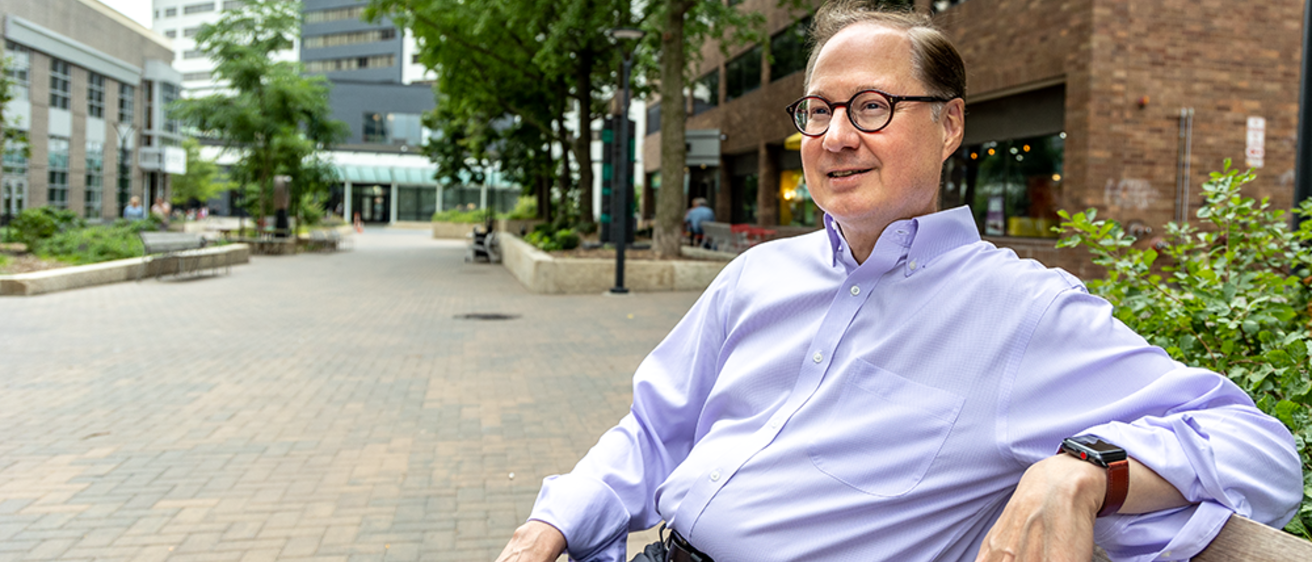
One of the beautiful things about returning to a place you love after being away for a time is that you have a renewed appreciation for what’s unique and special about that place while being clear-eyed about how it will get to the next level.
Iowa is certainly one of those special places.
You can see that in Stanford’s eyes and his smile when he says, “It’s good to be home.”
